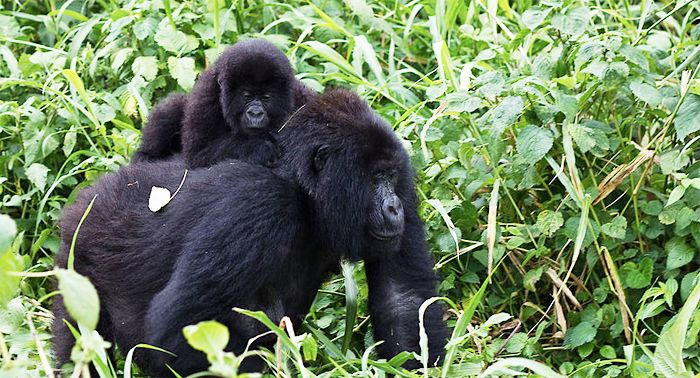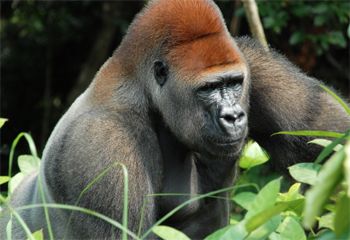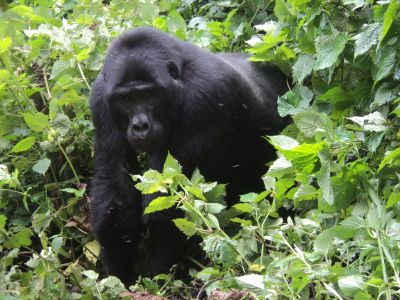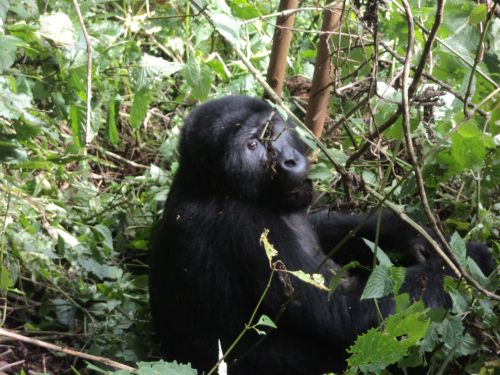

I was originally doubtful about going to see the mountain gorillas. After living in Kenya for some time, I had come across many people who had been gorilla tracking in Uganda and Rwanda, and I never met anyone that did not regret the $500-750 price tag for a gorilla tracking permit. Nevertheless, I was pretty hesitant to spend several hundred dollars for a single permit that could possibly lead to dead ends, no sightings, and no second chances. Finally, while planning a recent November trip to Uganda, I decided that my tenure in East Africa would not be complete without a journey to see the magnificent mountain gorillas that had once come so close to extinction. I was also very curious about the gorilla tourism approach to conservation and wanted to experience it for myself.
To my pleasant surprise, I learned that the Uganda Wildlife Authority (UWA) was offering a low-season permit price of $350 (offered only in November and April). Up until the beginning of 2014, the gorilla tracking permits cost $500 in Uganda (they have since increased to $600) and $750 in Rwanda. The permits are purchased in advance and allow a person to view a specific group of gorillas in their natural habitat for up to one hour on a particular day. The revenue from the permits goes toward park maintenance and conservation activities.
The mountain gorilla (Gorilla beringei beringei) is classified as critically endangered on the International Union for Conservation of Nature’s (IUCN) Red List of Threatened Species. There are only two places to see the world’s remaining mountain gorillas: Bwindi Impenetrable National Park in southwestern Uganda, which contains around 400 gorillas, and the Virunga Mountains, which straddle the borders of Uganda, Rwanda and the Democratic Republic of the Congo (DRC) and contain approximately 480 gorillas. I would be tracking these great apes in Bwindi.
Bwindi Impenetrable National Park is an area that covers 320 square kilometers and is located along the border with DRC. Bwindi has been a UNESCO World Heritage Site since 1994 and is managed by the UWA. Its jungles are home not only to the gorillas, but also to many other species of mammals, birds and reptiles.
After spending a few days in Kampala, it was time to head west toward Bwindi. My guide, Brian, would lead the long, nine-hour journey from Kampala to a lodge outside of the park, and the gorilla tracking would take place the following day. The last hour of the drive took place in the dark and on a very bumpy, mountainous road, so I was looking forward to getting a better view of the area in the morning. Sure enough, the view the next morning was breathtaking and consisted of tall, lush green mountains slightly obscured by a thick morning fog. A number of children made their way to school along the road. It was quite chilly during the early morning hours, which was expected at such a high elevation.

A maximum of 88 permits can be issued daily for tracking in Bwindi. There are a limited number of habituated groups of gorillas in the park, and each permit allows for the tracking of one of these groups. Habituation is a process by which gorillas begin to see humans as neutral and non-threatening. Typically, gorillas are shy animals, and it can take several years for gorillas to become accustomed to the presence of other people.
A tracking group can have no more than eight people. My group was full and consisted of Americans, Australians and Spaniards. I had pre-packed a large amount of water, snacks and lunch, ready in case of a several-hour trek, though I was a little nervous that I had not brought a proper raincoat; even though the tree canopy was thick, we were told the rains could be heavy and sudden. Before setting out, our guides told us that once we located the band, we were to stay quiet and keep a minimum distance. Because the mountain gorilla shares up to 98 percent of its DNA with humans, a risk of habituation is that visitors can easily pass on sicknesses to the primates. Tourists are asked not to come on the treks if they are ill, even with a cold.
Each group of gorillas contains a single dominant silverback male. Subordinate males serve as guards for the rest of the group. We were told that the group we were tracking also had a few infants. Although we had no idea what was in store or how long the trek would take, I was excited that I was about to see the mountain gorilla up close in its natural habitat.
The mountain gorilla was first discovered by non-Africans in 1902 in the Virunga Mountains, and news of the discovery attracted hunters who were curious about the little understood creatures. In the decades that followed, the mountain gorilla experienced a dramatic decline in population due to war, disease, and increased hunting and capture. In 1925, a royal decree by Belgium’s King Albert created a gorilla sanctuary, Albert National Park, which eventually became Virunga National Park. In 1959, the American zoologist George Schaller undertook the first basic study of the mountain gorillas there.
But it wasn’t until the 1960s and 70s that the plight of the mountain gorilla was largely brought to the world’s attention by Dian Fossey, known for living among the gorillas in the Virunga Mountains. Fossey undertook a long-term study of the gorillas and demonstrated the process of habituation by trying to win the gorillas’ trust. “I imitated their feeding and grooming, and later, when I was surer what they meant, I copied their vocalizations, including some startling deep belching noises,” she wrote in the National Geographic essay, “Making Friends with Mountain Gorillas.” Fossey gave a personal account of her field studies in her book Gorillas in the Mist. Her passion and eloquence was obvious and led to a series of essays and interviews with international media that consequently raised global awareness about the gorillas’ dwindling numbers.
The reasons behind the declining population during the latter half of the 20th century were numerous. Fossey described the threat of human encroachment on their natural habitat, especially through the old tradition of cattle grazing, as a practice that was damaging Virunga National Park’s vegetation. Although mountain gorillas were not generally hunted for bushmeat, they often were injured or killed by traps that were meant for antelope and other animals. Mountain gorillas were also killed directly for their skins, and infants were often captured for sale to foreign zoos.
Fossey used active conservation methods to combat the threats facing gorillas. These methods included regular census counts of the population, poacher patrols involving locally trained rangers, and safeguarding of the gorillas’ natural habitat. They also included educational approaches to change attitudes and behaviors, and providing personal incentives to the local population to take pride in their natural heritage. Fossey emphasized the need for longer-term strategies to supplement the active conservation methods. Long-term study of the gorillas, international cooperation, and robust law enforcement for poaching are all crucial to the sustainability of conservation efforts.

Mountain gorilla tourism in other countries got a much later start. Political instability in Uganda kept much of the tourism at bay in the 1970s and 1980s. Before 1991, the Bwindi area was designated as a forest reserve, and rules and regulations were much more lax. Gorilla groups in Uganda were first habituated for tourism in the early 1990s. Continued instability in the DRC has made tourism and conservation efforts there much more difficult.
According to the International Gorilla Conservation Programme (IGCP), the estimated revenue from gorilla permits is $3 million annually, and when combined with related hotel and restaurant revenues, that figure is estimated to be some $20 million. Gorilla tourism has increased awareness about the dangers that mountain gorillas face while simultaneously creating jobs and generating income for conservation activities and for the surrounding communities. So long as habitat disruption and disease transmission by tourists are limited to the greatest extent possible, gorilla tourism can provide multiple benefits.
Disease transmission is, however, always a large concern. The gorillas come in close contact not only with tourists but also with park rangers and other conservation workers. Park rangers and conservation workers are normally tested regularly for tuberculosis and other contagious diseases, provided with vaccinations, and given masks and gloves to wear when coming in close contact with the gorillas. However, this is not done with tourists, and disease transmission from these visitors is always a large risk.
While the mountain gorilla is still critically endangered, the population has risen over the past few decades thanks to continuous efforts, dedicated conservationists and changing attitudes about the species. The total population of mountain gorillas was thought to be less than 400 in the early 1980s and had risen to 620 by 1989. According to a 2011 census, the number now stands at approximately 880.
While mountain gorillas were dangerously close to extinction at one point, I was able to come face-to-face with them with greater hope for their continued survival, thanks to extensive conservation efforts.
We did not have to trek long to locate the band, only a short 45 minutes.

She was calm and seemed completely unaffected by our presence, while the rest of us apes appeared slightly more impressed. I then heard sounds coming from our left. Another gorilla, very visibly pregnant, sat idly nearby. The gorilla to our right then suddenly decided to cross to the other side and came within inches of me. I was instinctively terrified and had to remind myself to stay still, as any frantic movements could scare my new friend. But I was continuously surprised by their calm. The pregnant female had started to collect small branches and very nimbly used her hands to pick the leaves and eat them. I have always known that gorillas are one of the closest relatives to us, but there was something about seeing them up close and personal in their natural habitat that really made it sink in.
As we watched, our guide ordered us to continue down a steep incline in order to find the rest of the members of the band. We encountered several more gorillas, including the silverback, the large protector of the group. He actually seemed quite shy and did not appear threatening despite his size. Every one of our group members was busy snapping photographs and taking videos, and I was slightly expecting one of the gorillas to snatch a camera out of someone’s hand. But they are probably used to the attention at this point.
On these excursions, once your gorilla group has been located, you and your members are allotted an hour to observe them. It is beyond me how this hour went by so quickly. I had mixed feelings when our time was up, and I had wished that we had seen the babies of the group (our guide indicated that there had been a fight between two of the gorillas earlier that morning and that the infant members of the group were likely in a “hiding” place). However, we did see a number of the adults, and I would have been happy to sit and watch them all day.
After the hour was up, we began our rather short trek back to base. We were presented with personalized certificates from the UWA. It was not yet even 11am and we had the rest of the day ahead of us. In my case, I think it was for the best, as it was starting to look like rain.
The threats to mountain gorillas should not be dismissed simply because their numbers are on the rise, especially given how quickly those numbers declined during the 20th century. If anything, it gives us an indication that tireless conservation efforts are working but must carry on to ensure continued survival. This cannot be done without dedicated people who work behind the scenes to monitor the gorillas and actively try to protect their habitats. But long-term education, awareness, and funding strategies, including responsible and sustainable gorilla tourism, can help supplement the actions of these dedicated conservationists while bringing other community and country-wide benefits.
All photos are copyright protected and may not be used without permission. All photos are courtesy of Sarah Abdelrahim. Lead image courtesy of Cai Tjeenk Willink, Creative Commons 3.0 licese, and second image courtesy of Pierre Fidenci, Creative Commons 2.5 license.